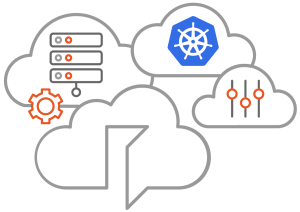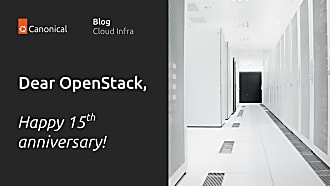Tytus Kurek
on 8 February 2021
Hybrid cloud – everything you need to know
Hybrid cloud allows businesses to optimise their costs associated with cloud infrastructure maintenance. It also brings many other benefits, such as business continuity, compliance, better scalability and improved agility.
According to the Forrester Wave: Hybrid Cloud Management, Q4 2020, hybrid cloud is an essential technology that every modern organisation is looking for and its adoption is only expected to grow in the following years.
In this blog, we cover everything you need to know about hybrid clouds.
What is a hybrid cloud?
Hybrid cloud is a cloud architecture that leverages more than one cloud provider at the time. Organisations are usually tied to a single vendor. This limits their capabilities to optimise infrastructure costs and leverage best-of-breed technologies and features. Although maintaining more than one cloud platform at the same time may seem like overkill, using a hybrid approach can actually result in a number of benefits. Hybrid clouds combine the advantages of individual clouds, while not putting additional pressure on internal budgets. Moreover, users can easily extend their hybrid cloud configuration with additional cloud providers, resulting in a so-called multi-cloud environment.

What are hybrid cloud building blocks?
In principle, a hybrid cloud consists of the following components:
- Public cloud – cloud infrastructure owned by a service provider and shared across multiple tenants who are external to the customer. This can be one of the biggest public clouds, such as AWS, Azure or Google Cloud.
- Private cloud – cloud infrastructure owned by the customer that is not shared with tenants who are external to the customer. Examples of private cloud platforms include OpenStack, VMware vSphere, AWS Outposts, etc.
- Hybrid cloud manager – software that is capable of spinning up applications on various cloud platforms and moving the workloads between them based on current demand for resources.

How does a hybrid cloud work?
Hybrid cloud is designed to provide better economics by leveraging both public and private cloud infrastructure at the same time. Since private clouds provide a better total cost of ownership (TCO) per virtual machine (VM) ratio, workloads should always run in the private cloud by default. However, during heavy load periods, users should be able to move some of their workloads to the public cloud. This is because the private cloud has a limited capacity. Whether the offloading process is manual or fully automated depends on the hybrid cloud manager being used. Once the demand for resources decreases, users should move their workloads back to the private cloud. Following this approach allows organisations to fully utilise their cheap private cloud platform and use more expensive public cloud infrastructure only when absolutely necessary.
What are the benefits?
Although both public and private clouds have their own advantages, using a hybrid solution brings additional benefits to the organisations:
- Maximum cost-efficiency – the hybrid cloud allows businesses to run their workloads where it makes the most sense from an economical point of view, achieving maximum CapEs and OpEx efficiency.
- Business continuity – as cloud environments are not fully resilient to failures, using more than one cloud at a time allows organisations to survive downtimes without a negative impact on the business.
- Compliance – since some organisations are obliged by local regulations to store their data on-prem, using a hybrid cloud approach allows them to achieve those goals, while still benefitting from the advantages of public cloud infrastructure.
- Better scalability – it is challenging to scale out the private cloud during heavy load periods without having extra hardware; simply offloading the private cloud allows to bypass those challenges.
- Improved agility – by using various cloud platforms at the same time it is easier to meet the diversity requirements with regards to architectures, hardware features, guest operating systems, etc.
Is a hybrid cloud for VMs only?
Historically, cloud environments used to be used for running traditional VM workloads only. However, those times are long gone. Nowadays users can also run their workloads on bare metal machines and inside of containers. All leading public cloud providers offer metal instance types. Also in the private cloud space, there are many solutions, such as Metal-as-a-Service (MAAS), which turn a data centre into a bare metal cloud. As for the containers, Kubernetes has dominated the market and became a de-facto standard for container coordination. Kubernetes can run both on-prem as well as in public clouds, making it an ideal candidate for hybrid cloud implementation, ensuring consistent user experience.

Are hybrid clouds secure?
In principle, the answer is yes. Although private clouds are considered to be less secure than public clouds nowadays (yes, you are hearing it right!), advances in cryptography and technology over the past few years have significantly improved the security level of private clouds. A properly protected cloud, running on a secure operating system, can host even very sensitive workloads and store confidential data. In order to improve the security level, even more, a bunch of compliance and hardening programmes are usually available for enterprise customers. Since public and private clouds are connected with a secure link, it is possible to encrypt the data both in transit and at rest.
How to set up a hybrid cloud?
Hybrid cloud deployment usually starts with bootstrapping a private cloud. Since the vast majority of organisations are already using public cloud infrastructure, there is not much to do in that space. However, building a hybrid cloud is an opportunity to revisit the offering from various public cloud providers and choose the one that provides all required features at the best price. Once both private and public clouds are up and running, the next step is to set up a secure link between both and deploy the hybrid cloud manager. Canonical is happy to assist at every stage of this process, from private cloud deployment to applications management in hybrid cloud environments.

Choose the cloud architecture that suits you best: Private cloud vs hybrid cloud, multi-cloud and more >
Get in touch
Get in touch with Canonical if you are interested in building a hybrid cloud infrastructure on Ubuntu.
Visit ubuntu.com/openstack and ubuntu.com/managed for more information about our products and services.



